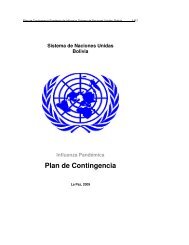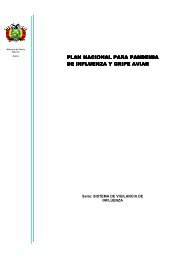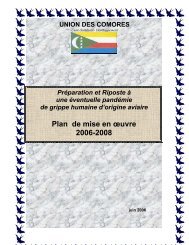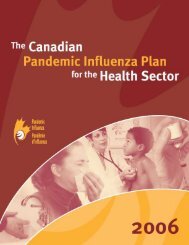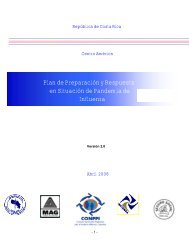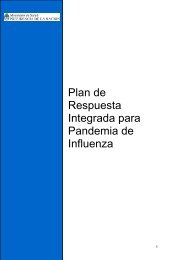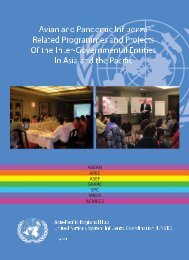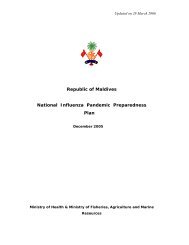Tanzania National Plan (January 2007)[1].pdf - Avian Influenza and ...
Tanzania National Plan (January 2007)[1].pdf - Avian Influenza and ...
Tanzania National Plan (January 2007)[1].pdf - Avian Influenza and ...
You also want an ePaper? Increase the reach of your titles
YUMPU automatically turns print PDFs into web optimized ePapers that Google loves.
<strong>Tanzania</strong> <strong>Avian</strong> <strong>Influenza</strong> <strong>National</strong> Emergency Preparedness & Response <strong>Plan</strong><br />
Normally there are an estimated 15 million water birds utilizing <strong>Tanzania</strong> for a<br />
significant part of their life cycle. The majority of these birds avoid contact with<br />
humans but are not averse to feeding <strong>and</strong> bathing alongside domestic poultry when<br />
the two are in proximal contact. Many of these wild birds also utilize water bodies<br />
shared by humans who often depend on surface water for bathing, irrigation, watering<br />
livestock <strong>and</strong> even drinking <strong>and</strong> other domestic activities.<br />
Bird families most likely to carry the H5 virus strain are the Anatidae, the ducks <strong>and</strong><br />
geese. <strong>Tanzania</strong> is the southern limit of the three most common Palaearctic ducks<br />
wintering in sub-Saharan Africa.<br />
It may well be that birds presently wintering in <strong>Tanzania</strong> have no pathogenic avian<br />
influenza virus. However, these may be making regular addition of new viruses to the<br />
diverse domestic poultry virus pool which may one day play a role in the avian<br />
influenza cycle <strong>and</strong> could be the prototype for HPAI viruses passing from resident<br />
water fowl to domestic fowl, particularly domestic ducks. Improved wild birds<br />
surveillance, including migratory birds as well as captive birds <strong>and</strong> exotic poultry,<br />
could only serve to increase the underst<strong>and</strong>ing of the epidemiology of avian influenza<br />
for the current H5N1 situation. It may also give further information on migratory<br />
species potentially involved in the spread of HPAI instead of making simple<br />
associations of wild bird flyways with outbreaks of AI that may be confounded.<br />
Raising public awareness <strong>and</strong> strengthening surveillance <strong>and</strong> laboratory diagnostic<br />
services are important components to be addressed. With the information provided,<br />
sound risk analysis will then feed into developing realistic, science-based emergency<br />
preparedness procedures with contingency action plans to strengthen early warning<br />
<strong>and</strong> early reaction to HPAI introduction in case of an incursion.<br />
2.4. Effect of <strong>Avian</strong> <strong>Influenza</strong> in Domestic Birds<br />
All recent outbreaks of HPAI in eastern Asia, Turkey <strong>and</strong> Nigeria have revealed that<br />
avian influenza strikes with devastating effects on birds, household economies for<br />
families that depend on poultry production, processing <strong>and</strong> marketing. In areas where<br />
it has been recorded. 140 million domestic poultry have died or have been killed.<br />
Economic losses associated with these losses are estimated at USD 10 billion.<br />
Signs of the disease at farm level, in susceptible populations are short incubation<br />
period of 3 to 7 days <strong>and</strong> sudden deaths of many birds without premonitory signs or<br />
with minimal signs of depression, in appetence, ruffled feathers <strong>and</strong> fever. Some birds<br />
may show weakness <strong>and</strong> a staggering gait. Alternatively hens may at first lay softshelled<br />
eggs, but soon stop laying. Sick birds often sit or st<strong>and</strong> in a semi-comatose<br />
state with their heads touching the ground.<br />
Profuse watery diarrhoea is frequently present <strong>and</strong> birds are excessively thirsty.<br />
Respiration may be laboured. The mortality rate varies from 50 to 100% for some<br />
strains of AI<br />
13


![Tanzania National Plan (January 2007)[1].pdf - Avian Influenza and ...](https://img.yumpu.com/36423433/13/500x640/tanzania-national-plan-january-20071pdf-avian-influenza-and-.jpg)
